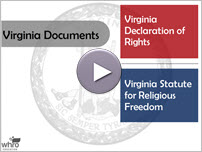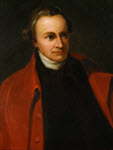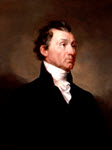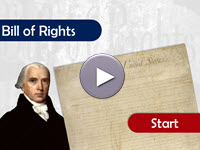The Virginia Documents and the Bill of Rights
Virginia Documents
 Several Virginia documents were influential to the foundation of American government. Two of these are the Virginia Declaration of Rights and the Virginia Statute for Religious Freedom. These documents contain the principles that helped pave the way for the Bill of Rights, which protects many of the individual freedoms American citizens enjoy. The Virginia Declaration of Rights stated that governments should not violate the people’s natural rights. The Virginia Statute for Religious Freedom supported an individual’s freedom of religious exercise and required a separation of church from government. Click the player button to begin.
Several Virginia documents were influential to the foundation of American government. Two of these are the Virginia Declaration of Rights and the Virginia Statute for Religious Freedom. These documents contain the principles that helped pave the way for the Bill of Rights, which protects many of the individual freedoms American citizens enjoy. The Virginia Declaration of Rights stated that governments should not violate the people’s natural rights. The Virginia Statute for Religious Freedom supported an individual’s freedom of religious exercise and required a separation of church from government. Click the player button to begin.
View a printable version of the interactivity.
Other Influences to the Constitution
 Other Virginians were influential to the ratification of the Constitution. While these men did not create a written outline calling for changes to the government, they were vocal with their opinions regarding the ways in which the government should function.
Other Virginians were influential to the ratification of the Constitution. While these men did not create a written outline calling for changes to the government, they were vocal with their opinions regarding the ways in which the government should function.
Virginian Patrick Henry, shown in the image on the left, is most recognized for his “Give me liberty” speech. Henry was against the ratification of the Constitution. Henry felt that the Constitution gave the central government too much power. In his view, the quickly growing populations of the North would eventually vote the South out of Congress. Without the addition of the Bill of Rights, Henry felt that people would be enslaving themselves and would not be safe from a powerful government.
 Virginian James Monroe, shown in the image on the right, became the fifth President of the United States. Long before he was elected president, Monroe was opposed to ratification of the Constitution without the addition of the Bill of Rights. Like Patrick Henry, Monroe felt the Constitution did not sufficiently protect citizen’s individual rights and that the government was too powerful.
Virginian James Monroe, shown in the image on the right, became the fifth President of the United States. Long before he was elected president, Monroe was opposed to ratification of the Constitution without the addition of the Bill of Rights. Like Patrick Henry, Monroe felt the Constitution did not sufficiently protect citizen’s individual rights and that the government was too powerful.
Even with opponents to the Constitution, leaders like George Washington and James Madison were major proponents for the document and the addition of the Bill of Rights eventually led to the ratification of the Constitution in 1789.
Federalists and Anti-Federalists
 The Federalists and the Anti-Federalists emerged as two groups standing on opposite sides of the ratification debates. Their conflicting perspectives on limited government and the protection of individual rights led to countless debates, both at state conventions and in the press. In this interactivity, learn about the political views and key leaders of each of these influential groups. Click the player button to get started.
The Federalists and the Anti-Federalists emerged as two groups standing on opposite sides of the ratification debates. Their conflicting perspectives on limited government and the protection of individual rights led to countless debates, both at state conventions and in the press. In this interactivity, learn about the political views and key leaders of each of these influential groups. Click the player button to get started.
View a printable version of the interactivity.
Ratification in Virginia
 In June of 1788, 168 delegates from Virginia met at the Monumental Church of Virginia to debate the Constitution. Of course, this meeting turned into a pivotal debate for the ratification of the Constitution. The main topic for this debate was the issue of individual rights.
In June of 1788, 168 delegates from Virginia met at the Monumental Church of Virginia to debate the Constitution. Of course, this meeting turned into a pivotal debate for the ratification of the Constitution. The main topic for this debate was the issue of individual rights.
The Federalists were led by James Madison. Other Federalists who participated in the debate were Edmund Pendleton, George Wythe, William Overton Callis, and John Marshall. George Washington did not attend the debate. However, Washington did write a letter that was read during the debates.
Opposing the Federalists were Patrick Henry, George Mason, William Greyson, James Monroe, John Taylor, and Benjamin Harrison. Patrick Henry served as the leader of this debate for the Anti-Federalists. The Virginian Anti-Federalists were opposed to ratification of the Constitution, fearing it would create a government that was too powerful.
The debate lasted for more than twenty days, until finally Virginia ratified the Constitution. The ratifying vote passed by a margin of 89 to 79 in favor of the Federalists. Virginia recommended that the Constitution add the Bill of Rights, but did not make the addition a requirement for ratification. Many ideas from this debate would be added into the Bill of Rights. A month later, Virginia became the tenth state to ratify the Constitution.
Bill of Rights
 In order to get the Anti-Federalists to ratify the Constitution, James Madison decided to write the Bill of Rights. The Bill of Rights originally included ten amendments that protected the rights of both states and individuals. The Constitution was ratified once the Bill of Rights was added. In this interactivity, explore the Bill of Rights while learning what freedoms it provides for the citizens of the United States.
In order to get the Anti-Federalists to ratify the Constitution, James Madison decided to write the Bill of Rights. The Bill of Rights originally included ten amendments that protected the rights of both states and individuals. The Constitution was ratified once the Bill of Rights was added. In this interactivity, explore the Bill of Rights while learning what freedoms it provides for the citizens of the United States.
View a printable version of the interactivity.
The Virginia Documents and the Bill of Rights Review
![]()
 Now that you have investigated the Virginia Documents and the Bill of Rights, complete this activity to check your knowledge. In this interactivity, read each statement and decide if it is true or false. Click the player button to get started.
Now that you have investigated the Virginia Documents and the Bill of Rights, complete this activity to check your knowledge. In this interactivity, read each statement and decide if it is true or false. Click the player button to get started.